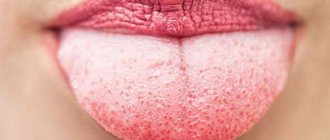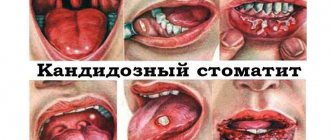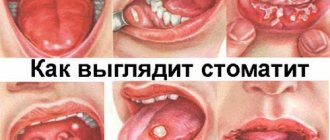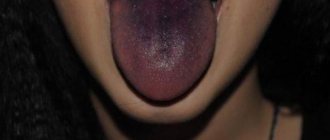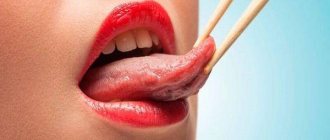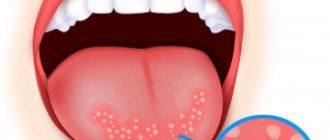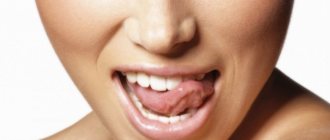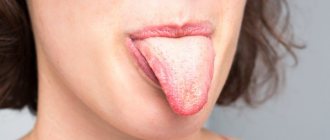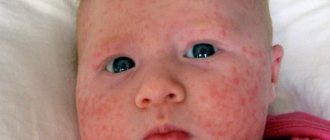We monitor the condition
First of all, it is necessary to analyze the baby’s well-being. If he eats well, sleeps, and doesn’t show anxiety, everything is fine.
It's another matter if there are pronounced problems with feeding. The child takes the breast or bottle with pleasure, starts sucking and immediately throws it away. At the same time, he expresses his displeasure through screaming and tears. There may be an increase in body temperature, moodiness, and poor sleep. This indicates a problem with sucking and swallowing milk.
So, white plaque in itself, without accompanying symptoms, is not terrible. If you have problems with sleeping or feeding, it’s time to take action.
Possible reasons
There are two main reasons for a “white tongue”:
- Milk deposits after feeding or regurgitation. Its distinctive feature is spotting. It does not form a dense layer and is easily removed with water. This is normal in children under one year of age.
- Candidiasis or thrush. The layer is thick, curd-like. It can affect not only the tongue, but also the palate, gums, and inner surface of the cheeks. As the disease spreads, it covers the mucous membranes of the groin area and the umbilical wound of the baby.
The rapid proliferation of Candida fungi indicates a weakened immune system and the development of the disease.
Plaque after feeding
A white coating on the tongue of a newborn is normal for up to 3-4 months, unless it is an infectious or fungal disease. The fact is that at an early age the baby has not yet fully developed salivation and not all milk residues are washed out from the walls of the mouth. Feeding in the first months of life occurs quite often (every 2 hours), the milk does not have time to be washed off. Therefore, a white mark remains in the mouth. This is the norm and does not pose any threat to the baby’s health.
Breast-feeding
When a child prefers his mother's breast and a white coating appears on the tongue, then first you need to figure out whether this is a consequence of taking milk or the beginning of the development of the disease. If the white coating can be wiped off with clean gauze or water, then there is no reason to panic. This is a normal phenomenon that does not require special care and will go away on its own. The child behaves normally, eats well, and is not irritable. The white tongue, which is often found in a newborn during breastfeeding, in this case does not need to be washed or cleaned. This can damage the mucous membrane, cause bleeding and cause infection. You need to sound the alarm if the plaque is not wiped off and spreads to the entire oral cavity.
Artificial feeding
When bottle-fed, the white tongue does not appear as often due to the fact that formula feeding occurs less frequently than breast milk. Babies consume an adapted milk formula at a set time, the intervals between which are greater than those of mother's milk lovers. Therefore, the remaining milk disappears before the next meal. The appearance of plaque in formula-fed children can also be on the throat tonsils, cheeks, gums and have a yellowish tint.
Causes of fungal infection
There are several reasons why a baby develops a white coating on the tongue. Among them:
- disturbances in the microflora of the gastrointestinal tract;
- taking antibacterial drugs;
- weakening of the body's immune system;
- dry mucous membranes;
- hormonal disbalance.
It must be said that Candida is considered opportunistic. Simply put, it is present in the body of every person, including infants. But until a certain moment it does not manifest itself in any way. When a provoking factor occurs, fungal microorganisms are activated and begin to grow rapidly, affecting the mucous membrane of the mouth and genital organs.
How to clean a newborn's tongue from thrush with soda
Soda solution can be used for thrush in newborns.
Breasts very often suffer from this problem, and when characteristic painful signs are found in the mouth, do not rush to use medications.
Thrush in children can be treated at home using baking soda. The method does not entail negative consequences. But before treating your child, consult your doctor.
This simple, accessible and safe method can completely relieve unpleasant symptoms, the development of which disrupts the baby’s sleep and causes pain while eating. Children begin to constantly be capricious and cry, which exhausts not only the little ones, but also their parents.
Candidiasis is a fungal infection. In fact, yeast-like fungus is a normal part of the human microflora, regardless of age and gender.
Candida albicans is present not only on the mucous membrane, but also on the skin.
If you create favorable conditions for the life of the mentioned pathogenic microorganisms, they will begin to actively multiply, which leads to a deterioration in the baby’s well-being, and is also reflected on the skin and mucous membranes.
The Candida fungus is always near each of us. Various food products and objects are a cozy “housing” for them. That is why the risk of thrush in infants, as well as in older children, is very high.
By regularly examining the child’s oral cavity (several times a day), you can promptly detect the emergence of a problem. The fact is that infants cannot describe the discomfort.
This can only be expressed by crying, and if you consider that thrush is a regular occurrence in children under 1.5 years old, then you should constantly study the child’s mouth, since the disease most often “settles” here.
Characteristic white spots can be found:
- on the inner surface of the cheeks;
- on the lips of the baby;
- in the gum area.
In addition, with candidiasis, children may develop small cracks in the area of the corners of the mouth.
Candidiasis spots cause burning pain, which is extremely unpleasant for the baby. These plaques often bleed. During thrush, children often secrete saliva and feel significantly worse.
The cause of this disease may be breastfeeding. Often, experts identify transmission of the disease from a sick mother to a child during lactation. Candidiasis can also “attack” infants who have disturbances in the functioning of the immune system.
The mentioned disease is not fatal, but if you delay the treatment of thrush, it can affect other organs of the baby, which will entail serious consequences.
Baking soda is endowed with unique properties and can be used in the treatment of thrush in newborns. This product is capable of providing;
- anti-inflammatory effect;
- antihistamine effect;
- antibacterial and antifungal effect on treated surfaces.
Using a soda solution in the fight against pathology allows you to quickly stop itching and relieve swelling. This liquid also relieves redness. Alkaline conditions are unfavorable for microbes.
Gently washing the resulting ulcers with a solution of sodium bicarbonate prevents them from spreading to other parts of the oral cavity.
Also, soda is able to neutralize acid, due to which the specific smell from the mouth disappears.
Before using this recipe, you should consult your doctor. To prepare a medicinal liquid, you should dilute soda in boiled water. To do this you will need to take:
- baking soda – 1 tsp;
- boiled water (slightly warm) – 250 ml.
Add the powder to the liquid and stir thoroughly.
This solution can be used not only to treat the oral cavity of a newborn, but also the breast (before feeding). You should also dip the pacifier in liquid before giving it to your baby.
How to use soda for thrush in adults - read the article at the link.
You can treat your baby’s tongue and mouth with a soda solution at any stage of the disease. If you wipe the affected areas correctly, this simple method will prevent the proliferation and development of pathogenic microorganisms.
Clean your baby's mouth as follows:
- Prepare the solution according to the above recipe.
- Wash your hands thoroughly and wrap your index finger in gauze or a sterile bandage.
- Dip the wrapped finger into the baking soda solution.
- Apply gentle pressure to your child's chin to open his mouth slightly.
- Gently treat the affected areas (usually cheeks, gums, tongue).
This procedure should be carried out 30 minutes before feeding. It is recommended to do this at least 5 times a day. To completely get rid of thrush, take a week-long course. The duration of lubrication can be reduced. As soon as the plaque in the baby’s mouth disappears, it is necessary to treat the mouth for another 2 days.
To avoid recurrence of the disease you must:
- sterilize bottles and thoroughly wash breasts before feeding;
- After eating food, you should give your baby some water (2-3 sips) to eliminate food debris accumulated in the mouth. This allows you to normalize the alkaline balance. These activities must also be carried out after regurgitation;
- carefully observe personal hygiene, as well as the rules of caring for the baby (timely water procedures, processing of objects that he uses).
Treatment for thrush may require the use of medications, which should only be prescribed by an experienced specialist. But before you start using the recommended medications, ask your doctor if a soda solution will help in your case.
Based on materials from supersoda.ru
You can find soda in almost everyone's home. It has long been used in baking, as a cleaning agent, and for cosmetic purposes. Many people are familiar with its use as an operative remedy for heartburn. It can also be used to care for a baby.
Baking soda is an odorless white powder; it is listed on food packages as a food additive E500. Widely used due to its properties:
- Alkaline - soda neutralizes acid, which helps get rid of unpleasant odors;
- Antibacterial, antifungal - pathogenic microorganisms die in alkaline conditions, washing small wounds with a solution helps to avoid germs getting into them;
- Anti-inflammatory, antihistamine – relieves itching, redness, swelling;
- Abrasive properties. Soda is part of powder cleaning agents; it removes dirt, disinfects and does not damage the surface.
Many people take a soda solution orally, but it is strictly forbidden to give it to a baby: in a fragile body, it can cause digestive problems.
Candida fungi are constantly present in the body along with other bacteria. Decreased immunity causes their active reproduction and contributes to the appearance of candidiasis (thrush). In newborns, it can occur in the mouth (stomatitis) for the following reasons:
- Fungi entering the body at birth, if the mother had the disease;
- Reduced protective properties of the body due to stress, colds;
- Drying of the mucous membrane in the mouth due to dry air in the room, frequent screams, difficulty breathing through the nose;
- Not very clean pacifiers. Some parents lick the fallen pacifier and give it to the baby. This is not scary, but if an adult has thrush, it can be transmitted to the baby.
Thrush is detected by a cheesy coating on the tongue. Normally, all babies have a little plaque, but with stomatitis it becomes uneven, the amount increases and can gradually spread to the gums, palate, and cheeks.
If you carefully clean your tongue, redness and sometimes small bleeding wounds are visible under the coating. They cause a burning sensation in the baby's mouth when he eats. The baby may even refuse to breastfeed, although he is hungry.
If the disease is not treated, it can spread to the microflora of other organs: the intestines, the genitourinary system in girls. You need to contact your dentist in a timely manner; if you can’t do this right away, you can use soda treatment:
- Dilute one teaspoon with warm boiled water (250 ml);
- Wrap your finger in a clean handkerchief or gauze (don’t forget to wash your hands before doing this), moisten it in the liquid;
- Lightly press on the chin so that the baby opens his mouth;
- Treat everything in the mouth – tongue, gums, baby’s cheeks.
- You need to lubricate your mouth half an hour before meals, 5-6 times a day. Baking soda prevents the development of fungi and relieves burning sensation in the mouth. Treatment for thrush takes about a week. When the curd coating in your mouth disappears, you need to continue processing for a couple more days.
The soda solution can be replaced with honey (in a 1:2 ratio with water) and also lubricated the newborn’s tongue. Honey tastes better, but can cause allergies, so you should use it carefully.
It is necessary to treat not only the baby’s mouth with the solution, but also the breasts before feeding. You can soak a pacifier in a soda solution before giving it to your baby.
Source: https://folkmap.ru/kandidoz/kak-chistit-yazyk-novorozhdennomu-ot-molochnitsy-sodoy/
How does infection occur?
The distribution routes are extensive. Infection can occur:
- intrauterine – the bacterium penetrates to the fetus through the placenta, umbilical cord;
- birth canal - while passing through the birth canal, the baby may become ill as there is contact with the lesion (about 70% of newborns become infected with thrush from their mother);
- in a hospital with insufficient sterility;
- at home, the child is not immune from various bacteria entering the body, but in the first months of life it is better to avoid this by ensuring the sterility of all surfaces and objects that the baby comes into contact with.
Thus, it is difficult to avoid infection. But to prevent the spread of infection, this can and should be done at the first symptoms of the disease.
How and with what to treat thrush in newborns and infants
There is no need to panic if you notice oral thrush in your child. Candidiasis in young children is very easy to treat and does not cause serious harm. It is necessary to show the baby to a pediatric therapist in time to determine the degree of development of the disease so that he can prescribe special treatment. Basically, drugs based on nystatin and levorin .
But it is not always possible to immediately consult a doctor for help. In such cases, you can resort to treatment yourself at home. For this, folk remedies are used:
- Soda solution - for preparation, you need to dilute a teaspoon of soda in a glass of chilled boiled water. Use this solution to wipe the baby’s mouth and rinse the pacifier in it, since soda can destroy microorganisms and neutralize the acidic environment;
- Honey solution - to obtain a remedy from honey for wiping the mouth, you need to dissolve a teaspoon of honey in a teaspoon of water and warm it up using a water bath. This method of treatment is effective because honey is a natural and strong antiseptic that relieves inflammation. But not every child’s body perceives it, as it can provoke an allergic reaction.
- Calendula infusion - a teaspoon of calendula flowers, pour a glass of boiling water and let it brew for an hour. Instead of calendula, you can infuse the following medicinal plants in the same way: chamomile, eucalyptus, sage or verbose leaves.
Do not forget that traditional methods of treatment are less effective and require more time compared to drug treatment, so they may not help your child.
Treatment
If you find out that the cause of a white coating on a baby’s tongue is leftover food, then after eating, give the child 1-2 teaspoons of boiled water. Usually this is enough to eliminate it. Do not try to wipe it off with gauze or cotton wool. Firstly, this will cause discomfort to the baby, and secondly, the mechanical impact can lead to injury to the tongue.
In case of a mild form of the disease, the doctor prescribes treatment of the oral cavity with soda solution. Be sure to boil pacifiers and bottles in a soda solution. Fungal microorganisms are very sensitive to it. Additionally, the use of special ointments and dental gels may be recommended.
The severe course of the disease is characterized by extensive damage to the mucous membranes and severe pain symptoms. In this case, the pediatrician, in addition to treating the mucous membranes, prescribes therapy with antifungal agents. Vitamin complexes and immunostimulants are required. Their task is to force the body to resist infection by suppressing the action of fungi.
If the disease is advanced and the white coating on the baby’s tongue is quite persistent, then treatment is difficult. It spreads to the pharynx and body temperature rises. When treating the oral cavity, bleeding ulcers form on the mucous membranes. These reasons require careful monitoring of the child’s oral cavity and timely detection of the initial stage of thrush.
The mild form goes away within 5-7 days, subject to the recommendations of the pediatrician. Do not try to fight the infection yourself. This can lead to a worsening of the situation and the transition of the disease from a mild to a severe form.
White coating on the tongue of a bottle-fed baby
The color and surface of a baby's tongue can reveal a number of medical conditions. If a white coating appears on the tongue of a baby during artificial feeding, you may need to consult a pediatrician. It all depends on the density of the coating, the child’s well-being, and whether the plaque is easily removed.
- What should a newborn's tongue look like?
- How to recognize “good” and “bad” white plaque
- What diseases cause a white coating to appear on the tongue?
- Why does white plaque appear?
- Folk remedies for white plaque on a baby’s tongue
- What medications help with white coating on the tongue?
- Prevention measures
- Advice from Dr. Komarovsky
What should a newborn's tongue look like?
If the baby is healthy, his tongue looks like this:
- soft to the touch;
- pale pink color;
- moderately humid;
- with a flat surface and a longitudinal fold;
- not painful;
- with no unpleasant odor.
How to recognize “good” and “bad” white plaque
The appearance of a whitish coating is not always an alarming sign. The main food for artificial babies is formula milk. It is normal for white food particles to remain in your mouth.
This type of plaque can be identified by several signs:
- It appears after eating;
- Visible on the tongue and mucous surface of the cheeks.
- Under its loose structure, the papillae of the tongue are easily visible.
- There are no signs of inflammation in the oral cavity.
You can offer your baby some water shortly after feeding. Perhaps it will wash away the remaining formula.
If the baby looks healthy, does not refuse to eat, there are no excessive whims and other signs that worry parents, there is no need to worry.
“Bad” plaque has a dense consistency, similar to lumps or flakes of cottage cheese. Such manifestations may indicate candidiasis (thrush), as well as a number of other disorders in the baby’s body.
To dispel all doubts, it is better to consult a pediatrician.
What diseases cause a white coating to appear on the tongue?
In addition to thrush, a white mass on the tongue may indicate:
• Viral stomatitis, often accompanying other infectious and viral diseases. Among them are chickenpox, measles, scarlet fever.
• Problems with bowel function.
• Dysbacteriosis. In this case, plaque appears on the entire surface of the tongue.
Also, a white coating may appear with a sore throat. Then no separate treatment is required. Having treated your baby for a sore throat, you will be able to get rid of plaque on the tongue at the same time.
Why does white plaque appear?
As a rule, the causes of occurrence are divided into 2 groups: safe and unsafe.
Food particles remaining on the tongue are considered safe. In this case, the white coating does not need to be removed. It goes away on its own. Usually when the baby drinks water.
Unsafe ones include:
- weakened immunity, low hemoglobin;
- diabetes;
- neurosis and other disorders in the central nervous system;
- infectious and viral diseases;
- interruptions in the functioning of the digestive system;
- antibiotic treatment;
- poor oral hygiene.
It is better not to engage in self-diagnosis and treatment. Only a doctor will be able to say exactly what caused the whitish coating to appear.
He will suggest the correct treatment and preventive measures.
Folk remedies for white plaque on a baby’s tongue
If plain water does not remove the coating, there are a number of folk remedies that you can use.
One of the most popular is a soda solution. They moisten a sterile bandage or gauze and lightly rub it over the tongue.
Strong mechanical impact is strictly prohibited. This can damage the child’s tongue, only making the situation worse.
Some mothers remove whitish plaque with honey. This product has good anti-inflammatory and antimicrobial properties.
Honey is applied to a sterile bandage or cotton pad, then the surface of the tongue is lightly treated.
It should be remembered that honey is not suitable for all infants. This is a strong allergen that can cause a negative reaction.
Another way to get rid of the whitish coating is lemon juice. Natural liquid squeezed from lemon is used. It is also used to wipe the baby's tongue.
What medications help with white coating on the tongue?
Treatment should only be prescribed by a doctor, depending on the disease that caused the white coating on the tongue.
From dysbacteriosis
In this case, it is important to suppress pathogenic microflora and increase the number of beneficial bacteria. This requires complex treatment.
As a rule, it includes pro- and prebiotics, as well as absorbents.
Children under 1 year of age are prescribed medications:
- To get rid of harmful microflora: colibacterin, bificol.
- To increase the number of beneficial bacteria: bifilis, bifiform, normoflorin B.
- Lactose-containing preparations: normoflorin, acipol, lactobacterin.
- Absorbents: enterosgel, smecta, neosmectin.
For gastritis with high acidity
Complex treatment will also be needed here. To reduce excessive acidity, the doctor prescribes antacid medications.
It is important to choose drugs that are not absorbed by the body. Among them: Maalox, Almagel, Phosphalugel. To relieve the baby from pain, no-shpa and papaverine are prescribed.
For intestinal diseases
Treatment is prescribed after identifying a specific disease.
If there is an inflammatory process, the baby may be switched to soy-based food. Medicines prescribed: salofalk and pentasa.
If irritable bowel syndrome is determined, the doctor will prescribe espumisan or Plantex.
When the intestinal tract is damaged by parasites, albendazole, piperazine, and pyrantel are prescribed.
Useful tips for mothers: MIXED AND ARTIFICIAL FEEDING
If the baby becomes infected with an acute intestinal infection, treatment is determined depending on the pathogen.
For viral stomatitis
Antiviral medications are prescribed. For children under one year of age, this is Viferon-gel and 0.25% oxolinic ointment.
For candidiasis
When fighting thrush, topical antifungal drugs are applied to the plaque-covered surface. Among them: pimafucin suspension and Candida gel.
Prevention measures
To prevent your child from developing oral diseases, including white coating on the tongue, it is important to follow simple rules:
• Wash your hands with soap before handling your child.
• Boil or at least pour boiling water over the baby's pacifier and bottles.
• Have separate dishes for him so that he does not become infected with thrush from other family members.
• Do not kiss the baby on the lips; his immunity is still weak to cope with many viruses and bacteria.
Advice from Dr. Komarovsky
The doctor points out what should not be done if the baby is diagnosed with candidiasis or stomatitis.
Parents should not:
• Manually remove plaque from the surface of the cheeks and tongue.
• Cauterize white formations in the mouth with alcohol-containing solutions, iodine, and brilliant green.
• Give the baby antibiotics or lubricate the tongue with medications containing them.
The pediatrician advises to help the child’s body cope with the disease in simple ways. In order for the ulcers to heal faster, it is important to increase the protective properties of children's saliva.
To do this, it is necessary to maintain the correct temperature in the baby's room. It should not exceed 18-20 degrees.
Also, the air must be sufficiently humid. Saliva will not dry out and lose its bactericidal properties at a humidity of 50 to 70 percent.
To prevent white plaque from becoming a sign of disease, parents need to carefully monitor the hygiene and health of the child.
If alarming symptoms appear, it is better not to self-medicate.
Only a doctor should make diagnoses and prescribe medications. This way the baby will be protected from many problems and will grow up healthy to the delight of mom and dad.
- about the author
- Recent publications
Arina Nagovitsyna
author of the publication (site editor)
JOURNALIST Higher education: Faculty of Journalism and Mass Communications
Arina Nagovitsyna recently published (see all)
- What can a child at 3 months - 09/12/2019
- What a 2 month old baby can do – 09/11/2019
- Which formula to choose when mixed feeding - 09/10/2019
Treatment of the oral mucosa
If the doctor confirmed the diagnosis and recommended cleaning the oral cavity with a soda solution, you should not ignore the procedure. Prepare a solution at the rate of 1 tsp. per glass of warm boiled water. Wrap a bandage around your index finger and dip it in the solution. Then carefully treat the affected surface. The procedure must be carried out 5-6 times a day.
Do not use force when trying to erase plaque. Be sure to wash your hands before each procedure. Prepare a new solution each time by dissolving baking soda in warm water.
Thrush in newborns in the mouth: treatment with soda solution
A solution with soda is an effective treatment in the fight against microorganisms of the fungus Candidiasis.
This remedy is available to every mother to treat her child. When treating with soda, do not forget to be careful in the dosage of the solution, since newborns still have very delicate and thin skin that can be damaged. To properly treat the mucous membrane of a newborn in the mouth, you need to prepare a napkin or gauze swab . Then moisten a napkin or tampon in a soda solution and carefully wipe the baby’s mouth and tongue without causing pain. Do not try to immediately remove this white plaque, because the inflammatory process continues underneath it. Sometimes, these plaque spots can even bleed. That is why you cannot scrape off this plaque, but simply moisten it and wipe it.
For a quick and high-quality recovery, this procedure should be performed up to five times a day, approximately every 2 to 3 hours. As a rule, treatment lasts from 3 to 5 days. To prevent your baby from becoming infected again, if you are breastfeeding and treating him at the same time, be sure to wipe his nipples with a soda solution before and after feeding. At the same time, it won’t hurt to treat all objects that constantly fall into the child’s mouth: a pacifier, a bottle, various toys, etc.
Reasons that require examination of a child
White coating on the tongue, the most common causes of which are milk residues and candidiasis. But there are a number of other diseases in which a similar picture can be observed. These include:
- Viral stomatitis. Plaque often accompanies viral and infectious diseases such as chickenpox, measles, scarlet fever, and tonsillitis.
- Dysbacteriosis.
- Gastritis with increased acidity of gastric juice. In this case, plaque forms on the middle part of the tongue.
If there is a suspicion of these pathologies, the child must be immediately shown to a doctor. He will determine the true cause, prescribe the necessary tests and prescribe treatment.
Symptoms indicating danger
Plaque on a child’s tongue may indicate problems with the digestive system, viral diseases of the throat, lungs, bronchial tubes, and also indicate the development of an infectious disease. If the white coating has a curd-like structure, areas of wounds, or inflammation, then you should definitely consult a doctor.
White tongue and bad breath
A change in bad breath along with white plaque may also indicate the development of various diseases. These include viral diseases (sore throat, flu, acute respiratory infections, pharyngitis, tonsillitis), bronchial and lung diseases (bronchial asthma, bronchitis), as well as disruption of the gastrointestinal tract. Diabetes mellitus can also be suspected by the smell of acetone from the mouth and the presence of a grayish coating on the tongue.
Coated tongue and high fever
If, along with external changes in the mucous membrane, the temperature rises, then we can talk about the progression of the infectious disease. It can be either an ordinary sore throat or ARVI, or measles, diphtheria, scarlet fever. It is imperative to consult a doctor to make a diagnosis and prescribe the correct treatment. If the plaque occurs due to a sore throat or other viral infection of the non-oral cavity, then it is not worth treating it separately; it will go away on its own along with the illness that provokes it.
If a white coating on the tongue is accompanied by a high temperature, then this is a cause for concern.
